Introduction
In this article, we review the 6-Liter model of the Platypus GravityWorks Water Filter, intended to provide water for groups and for basecamp scenarios. The potential advantages of this gravity-powered system are the saving of time, effort, and weight in purifying water for groups.

The GravityWorks system has been around since 2008 and is a mature product. We reviewed the 4.0 L incarnation of this filter in 2016. That review found the GravityWorks system to be robust and easy to use, offering good value for weight. According to the design team at Cascade Designs (parent of Platypus), the current version of the filter is little changed from previous models. The most significant change is that the cartridge walls are now thinner. The team found that they could save a bit of weight there without sacrificing robustness or reliability.
Our previous review focused on qualitative factors: ease of use, quality of build, and design. Our current review expands on those observations with a quantitative analysis of key performance factors. Together these reviews should give you a good sense of what to expect from the GravityWorks filter, and whether it is a good fit for your filtration needs.
About This Review
This Limited Review examines some of the key performance parameters of the system: rate of filtration, how this rate is affected by water quality and hydrostatic head, and how this performance declines with use. I also make a qualitative assessment of ease of use based on my experience with similar previous models and compare the GravityWorks filter with its nearest competitors.
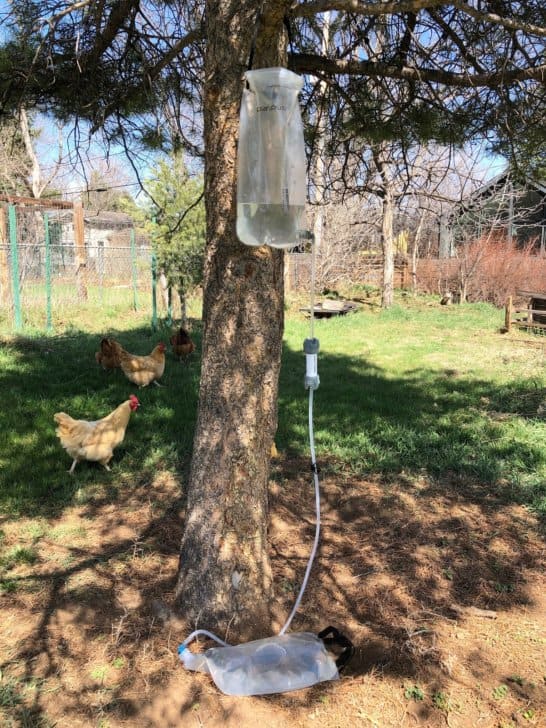
Features and Specifications
- Gravity driven
- Effective against bacteria and protozoa, but not viruses
- Meets EPA and NSF standards for removal of 99.9999% of bacteria and 99.9% of protozoa
- Pore size: 0.2 µm
- Field-cleanable by backflush
- Hollow-fiber filtration media
- Wide-mouth collection reservoir
- Simple operation controllable by in-line clamp
- 6.0L capacity
- Filtration rate
- Claimed: up to 1.75 L/min
- Measured: see text
- Weight:
- Claimed: 12.3 oz (350 g)
- Measured: 12.7 oz (360 g)
- Packed size: 12 x 6 x 3 inch (30 x 16 x 7 cm)
- Replaceable cartridge treats up to 1500 L
- Polyethylene reservoir, silicon tubing

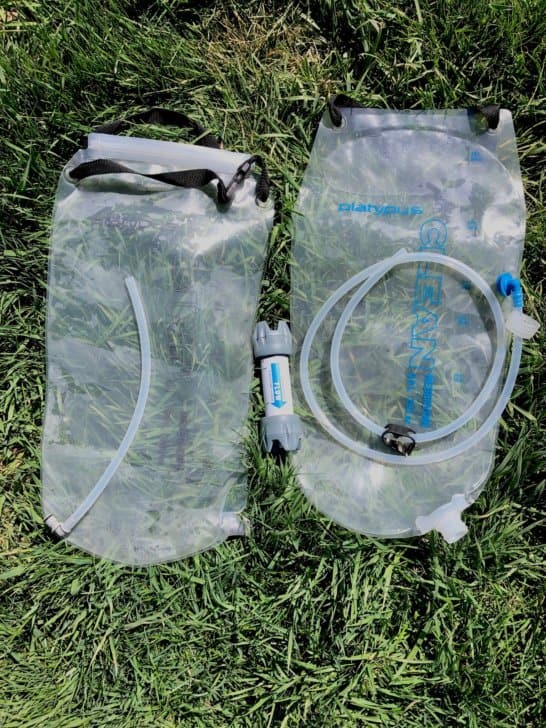
Performance Analysis
I tested the GravityWorks filter for several parameters:
- flow rate with both clean and dirty water sources,
- dependence of flow rate on hydrostatic head, and
- loss of flow rate as a function of cumulative liters filtered.
Those are a fair number of variables to examine, and they are variables that I expected to show some dependence on each other. Rather than examine each in a traditional one-factor-at-a-time experimental design, I used statistical design of experiments methods to minimize the number of runs needed to extract the desired information.
To measure the effects of hydrostatic head, I hung the collecting reservoir 3, 5, and 7 feet (the maximum extension of the tubing) above the receiving reservoir. I used tap water for clean water. Per the manufacturer’s recommendation, I backflushed the filter with 0.5 – 1.0L of clean water before every run. To generate dirty water, I stirred up the algae from a downspout rain barrel in my garden and withdrew water from that barrel.

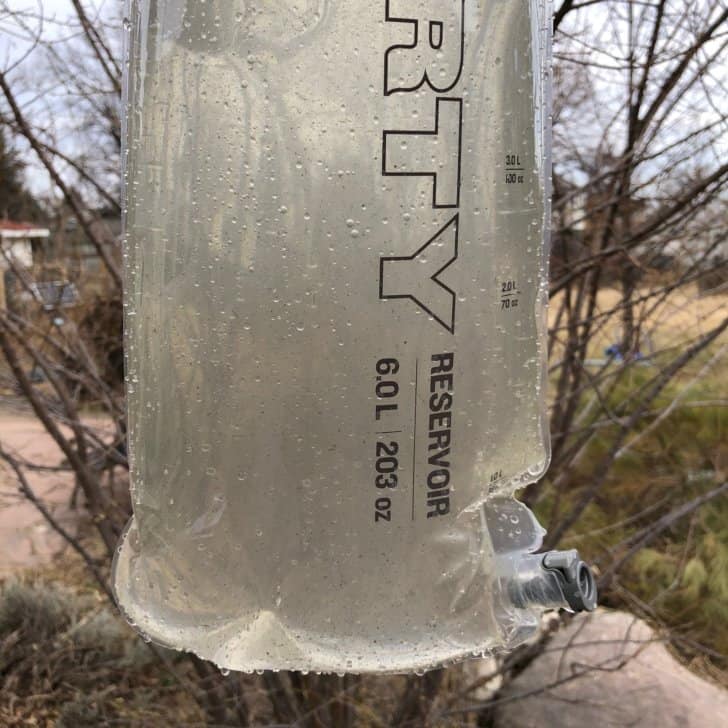
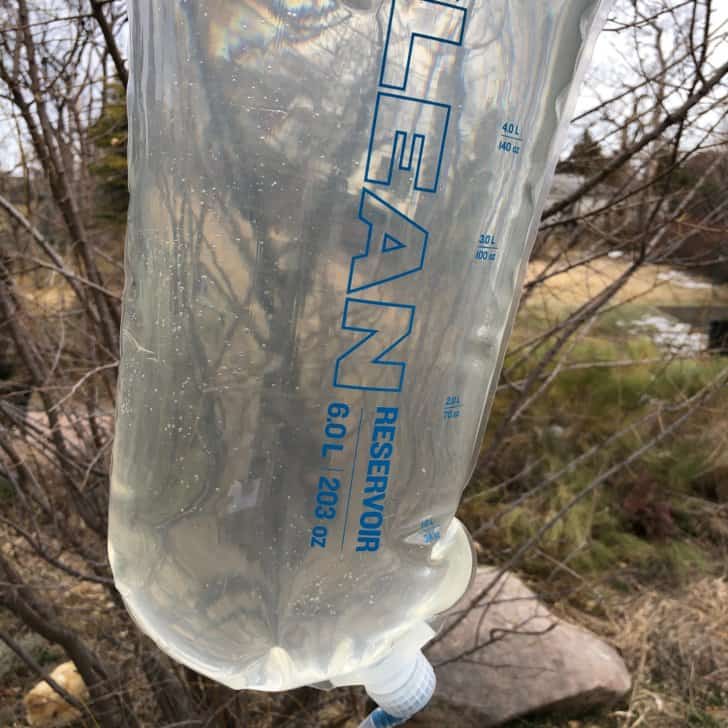
Experimental Results
Here’s my raw data:
| hydrostatic head (ft) | water quality | filtration time time (hh:mm:ss) | filtration rate (L/min) | cumulative water filtered (L) | ambient temperature (F) |
|---|---|---|---|---|---|
| 7 | clean | 0:03:47 | 1.59 | 0 | 50 |
| 7 | clean | 0:04:02 | 1.49 | 12 | 50 |
| 7 | clean | 0:04:27 | 1.35 | 18 | 50 |
| 7 | clean | 0:03:56 | 1.53 | 24 | 50 |
| 7 | clean | 0:03:50 | 1.57 | 30 | 50 |
| 5 | dirty | 0:05:53 | 1.02 | 36 | 58 |
| 7 | clean | 0:04:39 | 1.29 | 42 | 58 |
| 3 | clean | 0:09:39 | 0.62 | 48 | 58 |
| 3 | dirty | 0:16:49 | 0.36 | 54 | 58 |
| 7 | dirty | 0:06:35 | 0.91 | 60 | 40 |
| 3 | clean | 0:11:14 | 0.53 | 66 | 40 |
| 3 | dirty | 0:21:10 | 0.28 | 72 | 40 |
| 5 | clean | 0:08:15 | 0.73 | 78 | 40 |
| 7 | clean | 0:05:56 | 1.01 | 84 | 47 |
| 3 | dirty | 0:22:54 | 0.26 | 90 | 47 |
| 7 | dirty | 0:16:38 | 0.36 | 96 | 47 |
| 5 | clean | 0:11:58 | 0.5 | 102 | 47 |
| 3 | clean | 0:17:14 | 0.35 | 108 | 47 |
| 5 | dirty | 0:15:39 | 0.38 | 114 | 49 |
| 3 | clean | 0:17:20 | 0.35 | 120 | 49 |
| 7 | clean | 0:06:34 | 0.91 | 126 | 49 |
| 5 | clean | 0:08:30 | 0.71 | 132 | 50 |
Note: Data from the second run (the 6L run) excluded due to a kink in the tubing.
I used these data to create a multivariate model of test performance using a response surface design. A Bonferroni correction was applied to reduce the false discovery rate of significant factors. Factors that were thus excluded were: temperature, non-linearity of hydrostatic head, and interaction of water quality on hydrostatic head.
Significant factors and their Bonferroni-corrected P values are:

The derived multivariate model fits well to the observed data (R2=0.94, RMSE=0.13 L/min, Pvalue < 0.0001).
Here is a graphical representation of the model, showing the relative effects of each of these factors:

Conclusions from this analysis:
- Dependence on the hydrostatic head is about 0.2 L/min/ft. Not surprisingly, the higher you hang the filter, the faster filtration rates will be. This dependence is linear over the range tested.
- The maximum filtration rate is about 1.5 L/min, not 1.75 L/min as claimed by the manufacturer.
- Dirty water is filtered about 17% more slowly than clean water. This is less of an effect than I expected. Obviously this depends on just how dirty the water is. A limitation of this result is that I tested scummy (algal) water, but not silty water, which might behave differently.
- Filtration rate drops with use. The initial rate of 1.5 L/min dropped to 0.9 L/min after 100 L. That’s a lot. To be fair, most users won’t be filtering as much dirty water as I did in this testing and should see a lower loss of filtration rate. Unless you are hiking the Arizona Trail, I can easily imagine that the drop in rate would be much slower than what I measured.
- The loss of filtration rate is non-linear and appears to slow down after an initial rapid drop. This effect is of borderline statistical significance (p = 0.06) but still more likely than not to be real. My physical interpretation of these results is that there are a finite number of sites on the filter to which scum will stick irreversibly.
Qualitative Observations
My testing plan was to use this filter on a Sierra Club ICO trip with middle-schoolers to Canyonlands National Park in April 2020. The coronavirus outbreak led to the cancellation of all our outings for the time being. However, I have used earlier versions of this filter on previous outings. As the basic design and form factors appear little changed, I think it is valid to apply those experiences to the current product.
The operation of this filter system is very simple. Both elementary and middle-school kids have no trouble in both setting it up and getting water from it. Collecting water from still sources using soft-sided containers is always harder than using rigid containers. However, the wide mouth and stiff zip-seal at the opening make collection from still water relatively easy.
Backpacking Light publisher Ryan Jordan has used large-volume Platypus GravityWorks filters for several years with Scouting groups in mountainous areas of the Northern Rockies, including Glacier National Park, Yellowstone National Park, the Bob Marshall Wilderness, and the Absaroka-Beartooth Wilderness and notes that as long as they aren’t filtering extremely silty water, the efficiency of using a system like this as a group filter far outweighs the filtration rate slowdowns that come with filtering clean water.
Earlier versions of this system featured an adapter that allowed filtration directly into a variety of bottles, rather than the supplied Platypus bladder. Although this was convenient, it was not unusual for kids to fill their bottles and forget to clamp the line shut, draining filtered water out onto the ground. Filtration into a closed reservoir prevents this waste.
The narrow mouth of the clean reservoir also makes it difficult to use for water collection, thus minimizing the risk of cross-contamination.
Performance Summary
| criterion | observations and issues |
|---|---|
| Filtration rate | 1.75 L/min claimed, but 1.5 L/min max rate for a full 6 L batch observed. Not surprisingly, this rate decreases with reduced hydrostatic head, and for dirtier water. |
| Ease of use | Simple to assemble. Wide, rigid mouth facilitates water collection. Walkaway operation. Easy to backflush. |
| Robust design | No moving parts or power sources required. Sturdy construction. Very few failure modes. |
| Product lifetime | Significant drop in filtration rate with use. |
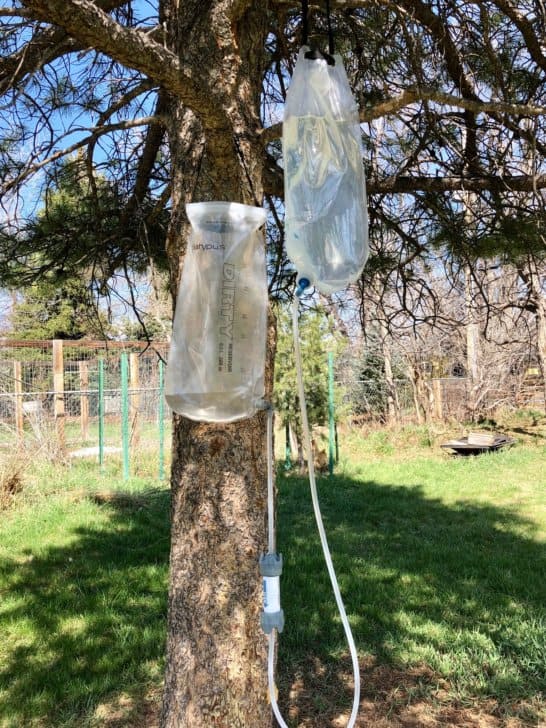
Commentary
Gravity filtration technology is mature. The first version of the Platypus filter was launched in 2008. With several well-established competitors in the field, there are no striking innovations that distinguish one product from another. Instead, these products are differentiated on the basis of execution. I reached out to the design team at Cascade Designs (parent of Platypus) for their view of what distinguishes their product from the competition:
- Clean side/dirty side complete system. Makes it easy to backflush and purge air bubbles, reduces the risk of contamination, provides storage capacity so that clean water is always available. Comment: These claims are fair. Several competitors do not include a clean water reservoir. Backflushing only requires placing the clean reservoir above the dirty for about a minute.
- Internal testing. Platypus does actual microbiological testing rather than relying on dry particles to verify manufacturing quality. Comment: I can’t vouch for competitors’ methods, but microbiological testing is the gold standard. Bacteria (especially Gram-positive cocci, which can be < 0.5 µm) are flexible and can pass through filters whose pore size is smaller than they are. Also, nominal pore sizes are an average over a distribution. The width of that distribution matters greatly to actual filter performance.
- Taste-free. The proprietary film of Platypus products has a thermoplastic polyurethane outer layer that provides strength and durability and is lined with an inner-water contact polyethylene layer. This construction keeps water from tasting like polyurethane. Comment: I did not detect any plastic flavor from the clean reservoir. I have had other products, notably an MSR Dromedary bag, that had a strong plastic taste (incubating several hours with a warm, dilute solution of Dr. Bronner’s helped fix this).
The Cascade Designs team also noted that they test 100% of filters inline on their production lines. They also believe that their lifetime claims are more realistic than those of their competitors, and plan to update this spec to best-case/worst-case (i.e., clean vs. dirty) scenarios. Comment: I noted a significant decrease in the filtration rate in less than 100 L use. However, the rate seemed to be stabilizing at about 1 L/min, which is still comparable to rates for mechanical filters.
Compared To
I’ve used the comparable Sawyer product on group outings. In my experience, it is a distinctly inferior product. Flow rates under the best of circumstances were significantly slower than the Gravityworks filter and it clogged readily. Repeated backflushing was required to get it to work at all.
The MSR Trail Base Water Filter System is more expensive, heavier, treats a smaller volume, and has a slower filtration rate. On paper, it loses out to the Gravityworks filter.
The Katadyn Gravity Camp 6.0L appears much more competitive:
| criteria | comments | edge |
|---|---|---|
| MSRP | Platypus $120, Katadyn $90. Katadyn does not include a clean reservoir. | Katadyn |
| weight | Platypus 12 oz (350 g), Katadyn 10 oz (283 g). The Platypus clean reservoir weighs 3.2 oz (90 g) and can be left at home, making it lighter in a comparable configuration. | Platypus |
| packability | Clean reservoir accounts for most of the small difference. | Katadyn |
| capacity | 6 L both | tie |
| pore size | 0.2 µm both | tie |
| backflushable | Platypus easy to backflush, Katadyn cartridge must be replaced | Platypus |
| filtration rate | Nominal rates 1.75 L/min Platypus, 1.9 L/min Katdyn. Measured rate 1.5 L/min Platypus. Katadyn claim not verified | Katadyn |
| rated cartridge life | 1500 L both | tie |
Strengths and Limitations
Strengths
- Walkaway operation, low hands-on time
- High capacity
- Robust design unlikely to fail in the field
- Field cleanable
- Good weight to capacity (volume) ratio for groups
- Easy to collect and transport water
Limitations
- Does not remove viruses or chemicals
- No adapter for wide-mouth bottles
- Requires trees or other support, preferably > 5 feet height
- Decreased filtration rate over time, even with backflushing
Closing Comments
The Platypus Gravityworks 6.0L Filter is a mature product that addresses the use cases of high-volume water treatment for groups and basecamp scenarios. It is simple to operate and is robust and reliable. It provides clean water at a higher rate and with less effort than mechanical pumps, and at a comparable weight. Its main limitations are that it will not remove viruses or chemicals and that it is more difficult to use in non-forest environments such as above treeline and deserts. I have used this filter for years on group outings and will continue to do so.
Where to Buy
Related Content
DISCLOSURE (Updated April 9, 2024)
- Product mentions in this article are made by the author with no compensation in return. In addition, Backpacking Light does not accept compensation or donated/discounted products in exchange for product mentions or placements in editorial coverage.
- Some (but not all) of the links in this review may be affiliate links. If you click on one of these links and visit one of our affiliate partners (usually a retailer site), and subsequently place an order with that retailer, we receive a commission on your entire order, which varies between 3% and 15% of the purchase price. Affiliate commissions represent less than 15% of Backpacking Light's gross revenue. More than 70% of our revenue comes from Membership Fees. So if you'd really like to support our work, don't buy gear you don't need - support our consumer advocacy work and become a Member instead.
- Learn more about affiliate commissions, influencer marketing, and our consumer advocacy work by reading our article Stop wasting money on gear.




Home › Forums › Platypus GravityWorks 6L Filter System Review